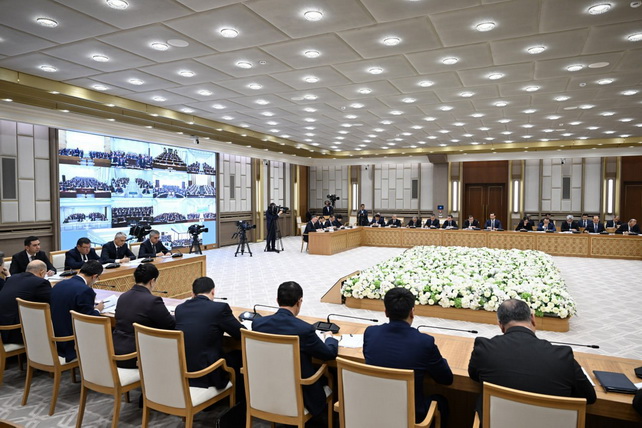
Uzbekistan Aims to Reduce Poverty to 4.5% in 2026
Uzbekistan Aims to Reduce Poverty to 4.5% in 2026
Tashkent, Uzbekistan (UzDaily.com) — On 19 November, under the chairmanship of President Shavkat Mirziyoyev, a video conference was held to review results and set key priorities for 2026 in the areas of poverty reduction and employment generation.
During the session, it was noted that the material and technical capacities of regional and district hokims (governors) and their staff have significantly improved, enabling more effective work at the local level, identifying initiatives during visits to each mahalla (neighborhood), and thereby improving citizens’ quality of life.
Since the beginning of 2025, the unemployment rate has declined to 4.9% compared with 5.5% last year. In several cities, including Bukhara, Kagan, Navoi, Zarafshan, Gazgan, Samarkand, and Shirin, the rate fell below 4%, approaching the level of natural unemployment for the first time. Some 302,000 families have moved out of poverty, and the overall poverty rate is expected to drop to 6% by the end of the year, compared with 8.9% in the previous year.
In the Khavast, Mirzaabad, Akaltyn, Dustlik, Pakhtakor, Farish, Buston, Vabkent, Mirishkor, Mingbulak, Uzun, and Pskent districts, the number of low-income families has decreased 4.5-fold.
Previously disadvantaged 105,000 families have begun receiving income. In 2025, 1,435 mahallas were officially recognized as “poverty-free areas” for the first time.
At the same time, the work of some hokims was criticized for leaving the poverty reduction agenda to chance despite available resources, failing to provide citizens with ready projects. As a result, the hokims of Denau and Chirakchi districts, along with their first deputies, were dismissed, and measures were taken against 20 other hokims. Since the beginning of the year, 261 responsible officials have been dismissed for irresponsible performance in poverty reduction and employment, and 492 individuals have received disciplinary sanctions.
The target for 2026 is to reduce poverty and unemployment to below 4.5%. To achieve this, 450 trillion soums in loans will be directed into the economy, of which 140 trillion soums will support small and medium-sized projects at the mahalla level.
The first focus area is employment through the construction sector. In 2026, investment projects totaling 675 trillion soums are planned, including 380 trillion soums for construction, which covers the building of 140,000 apartments. Each hokim, effectively utilizing these resources, could provide employment for 20–25 thousand people directly in construction and around 10 thousand through the created infrastructure.
For the first time, 20 trillion soums for mahalla infrastructure development will be allocated directly to regional budgets.
The second focus area is the development of the services sector, which shows high growth rates and strong employment potential, particularly in tourism. Infrastructure improvements are planned for 150 mahallas with high tourist potential, aiming to increase the volume of services to 10 trillion soums and create 45,000 jobs in trade and services. Each mahalla will receive 3–5 billion soums, and district banks will provide preferential loans of up to 150 million soums for guesthouse construction. Border and enclave districts are allocated 1 trillion soums for leisure and service projects, as well as for the development of 500 settlements along rivers and roads, with preferential loans of up to 1 billion soums.
This year alone, 255 24-hour streets with 11,000 service sector facilities were launched, employing around 27,000 people. In 2026, an additional 200 streets are planned, each receiving up to 4 billion soums, provided a clear “roadmap” is drawn up and work begins within a month.
The third focus area is industrial development. Production totaling US$52 billion is planned, with 3,500 projects worth US$22 billion in local industry, creating 130,000 permanent jobs. In 400 mahallas, furniture, handicraft, and garment production has already developed, and 50 new micro-industry centers will provide employment for another 10,000 people, with 200 billion soums allocated for their infrastructure.
The fourth focus area is agriculture. In 2025, 232,000 hectares of land were allocated to the population, providing income for 770,000 people. To increase profitability, one-third of farmers are instructed to adopt the practices of the Home Farming Schools in Termez, and export cooperatives are being established to guarantee product sales.
The fifth focus area is strengthening social protection for vulnerable families. In 2026, the project “Equal Opportunities – Inclusive Employment” will provide jobs for 40,000 people with disabilities and interest-free loans of up to 30 million soums. Social support and benefits will continue for at-risk families, including material assistance, child benefits, and 110 types of social services throughout the year.
The legalization of employment was also discussed.
The President emphasized that achieving all objectives is possible only with active involvement from ministers, hokims, and mahalla structures. The Prime Minister has been tasked with establishing the conference’s objectives as key performance indicators (KPIs) for 2026.
During the session, reports from regional and sectoral leaders were heard, as well as input from entrepreneurs who presented proposals for further employment development and poverty reduction.
#Shavkat Mirziyoyev